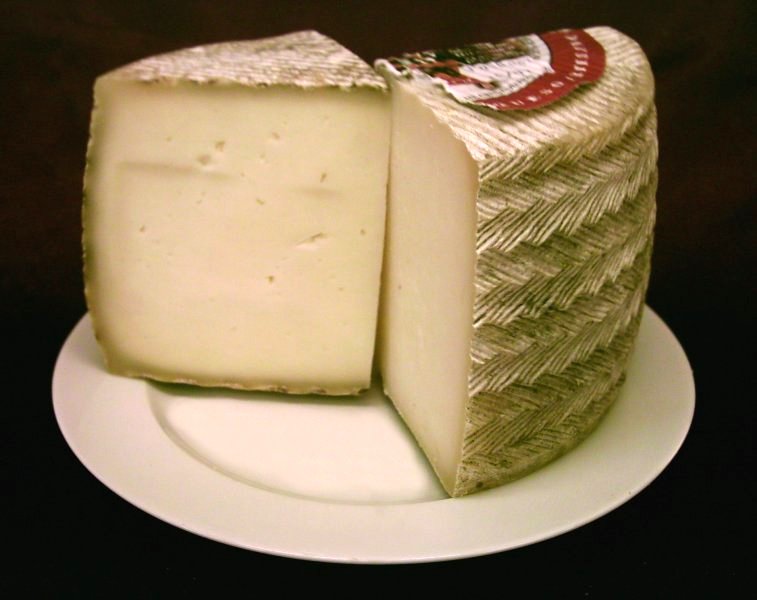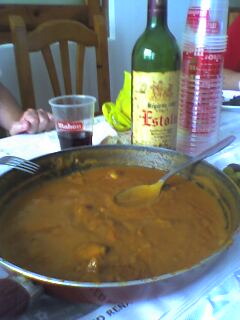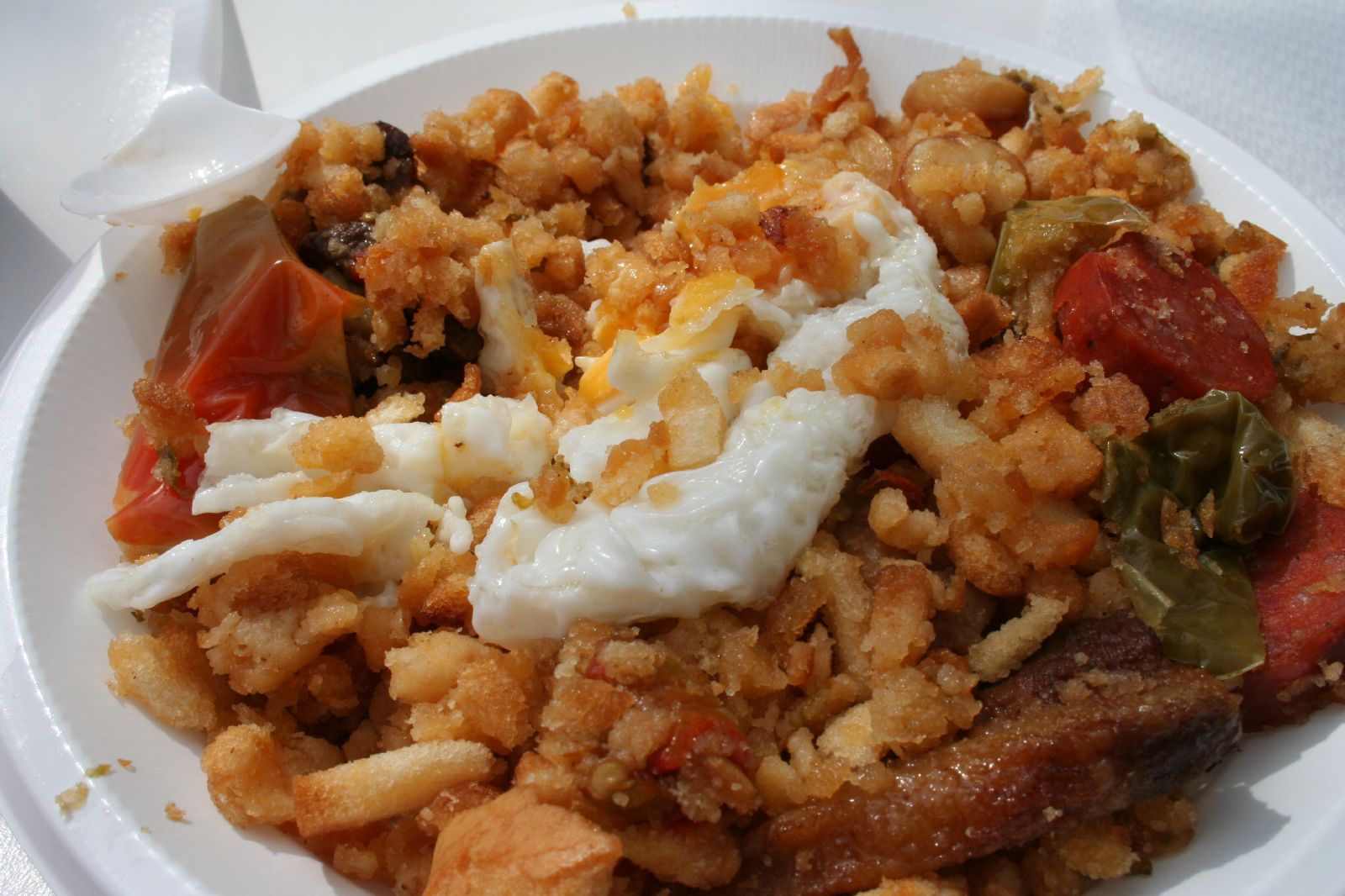Manchego cuisine on:
[Wikipedia]
[Google]
[Amazon]





 Manchego cuisine (Manchegan cuisine or Castilian-Manchego cuisine) refers to the typical dishes and ingredients in the cuisine of the Castilla–La Mancha region of
Manchego cuisine (Manchegan cuisine or Castilian-Manchego cuisine) refers to the typical dishes and ingredients in the cuisine of the Castilla–La Mancha region of
Consejo regulador del Queso Manchego
{{cuisines Spanish cuisine





Spain
, image_flag = Bandera de España.svg
, image_coat = Escudo de España (mazonado).svg
, national_motto = '' Plus ultra'' (Latin)(English: "Further Beyond")
, national_anthem = (English: "Royal March")
, ...
. These include '' pisto'' (a vegetable stew with tomato sauce), '' gazpacho manchego'', '' Manchego'' (a type of cheese), the white wine of La Mancha, and the red wine from Valdepeñas (DO).
The dishes and specialties of the region are generally sober and sensible, reflecting a modest, rural origin. They contain a limited number of ingredients that tend to be those most easily accessible by the locals. Dishes tend to be high in calories, ideal for the diets of laborers, farmers, and shepherds. The cuisine of this area was popularized by Miguel de Cervantes in his early 17th century novel '' Don Quixote'', where a number of traditional dishes are mentioned.
Staples
In La Mancha, traditional dishes include ''gachas
Gachas is an ancestral basic dish from central and southern Spain. Its main ingredients are flour, water, olive oil, garlic, paprika and salt.
Origin
Gachas are based on a very ancient Iberian flour-based staple food preparation.
Gachas may hav ...
de almorta'', a paste made with grass pea Grass pea is a common name for several plants, and may refer to:
*''Lathyrus nissolia''
*''Lathyrus sativus
''Lathyrus sativus'', also known as grass pea, cicerchia, blue sweet pea, chickling pea, chickling vetch, Indian pea, white pea and white ...
''(Lathirus sativus)'' flour, and '' tortas de gazpacho'', a flat bread that is the base for the "gazpachos", an elaborate dish appearing in El Quixote under the name of "galianos".
Fruits and vegetables
Local ingredients
One of the local vegetables is the bladder campion (''Silene vulgaris
''Silene vulgaris'', the bladder campion or maidenstears, is a plant species of the genus ''Silene'' of the family ''Caryophyllaceae''. It is native to Europe, where in some parts it is eaten, but is also widespread in North America, where it ...
'') plant, known colloquially as ''collejas.'' These plants are traditionally gathered in the mountains of La Mancha (as well as others parts of Europe, Africa, and Asia) and used for a variety of dishes.
Like most Spanish cuisine, many local dishes contain garlic
Garlic (''Allium sativum'') is a species of bulbous flowering plant in the genus '' Allium''. Its close relatives include the onion, shallot, leek, chive, Welsh onion and Chinese onion. It is native to South Asia, Central Asia and northeas ...
, including ' (salt cod with spring onions) and ' (salt cod with mashed potatoes, also called '). Additionally, the ''ñora'', a cultivated version of the '' Capsicum annuum'' pepper from Valencia, is often used in local dishes such as ''manitas de cerdo'' ( pig's feet) and '' migas''.
Standalone products include '','' a variety of small aubergines
Eggplant ( US, Canada), aubergine ( UK, Ireland) or brinjal (Indian subcontinent, Singapore, Malaysia, South Africa) is a plant species in the nightshade family Solanaceae. ''Solanum melongena'' is grown worldwide for its edible fruit.
Mo ...
that are grown in Almagro, Ciudad Real. These are seasoned and pickled according to a traditional recipe and usually eaten as a snack or side dish.
Vegetarian dishes
There are not many purely vegetarian dishes in the region. Some traditional vegetable-based dishes are ''pisto manchego'' (a local equivalent of ratatouille), ' (a salad of onion, tomato, and cucumber), ' (roasted red peppers), and '' gazpacho viudo'' (widower gazpacho, or gazpacho made with bladder campion leaves).Meat and fish
There are many local meat dishes, which consist primarily of sheep,goat
The goat or domestic goat (''Capra hircus'') is a domesticated species of goat-antelope typically kept as livestock. It was domesticated from the wild goat (''C. aegagrus'') of Southwest Asia and Eastern Europe. The goat is a member of the a ...
, and, to a lesser degree, beef
Beef is the culinary name for meat from cattle (''Bos taurus'').
In prehistoric times, humankind hunted aurochs and later domesticated them. Since that time, numerous breeds of cattle have been bred specifically for the quality or quantit ...
. The most important dishes are '' carcamusas'' (typical of Toledo), '' chanfarina'', roast lamb, ''cuchifritos
Cuchifritos () or cochifritos refers to various fried foods prepared principally of pork in Spanish and Puerto Rican cuisine. In Spain, cuchifritos are a typical dish from Segovia in Castile. The dish consists of pork meat fried in olive oil ...
'', '' migas'', '' gallina en pepitoria'' (chicken a la ), '' salpicón'', '' paturrillo'', and '. In areas where there is a lot of hunting, a number of game based dishes are also popular, such as '' conejo al ajillo'' (rabbit with garlic), ''liebre a la cazadora'' (hare hunter-style), and '.
La Mancha is a landlocked area with historically few bodies of freshwater to allow for the generalization of fish in its cuisine. The traditional fish is therefore '' bacalao'' (salt cod), which was historically imported from coastal areas and does not spoil. This can be found in some dishes, notably chickpeas with cod, eaten during Lent.
Cheeses
''Queso manchego'', or "cheese from La Mancha", is one of the most famous Spanish cheeses; more than 30% of Spain's cheese products are of this variety. It is a cured cheese made from the milk of local manchega sheep ''(Ovis aries ligeriensis)'', also called ''ovejas manchegas'') which abound in the pastures year-round. The mass of the cheese is fairly hard and dense, with an ivory-white color. It has a characteristically tart taste when it is new due to the natural flavor of the sheep's milk, though as the cheese ages it slowly develops a savory quality, which Carlos Yescas of the Oldways Cheese Coalition describes as "a delicate balance of buttery, tart, sweet, and nutty." The cheese is also high in calcium, Vitamins A, D, and E, and natural protein. There are several varieties of ''queso manchego'', differentiated by both curing time and individual tradition (some are submerged inolive oil
Olive oil is a liquid fat obtained from olives (the fruit of ''Olea europaea''; family Oleaceae), a traditional tree crop of the Mediterranean Basin, produced by pressing whole olives and extracting the oil. It is commonly used in cooking: ...
while curing).
Wines
Wine production is very important to the region, which has many protected designations of origin for the area. The major PDO is D.O. La Mancha, but others include: D.O. Valdepeñas inCiudad Real
Ciudad Real (, ; en, "Royal City") is a municipality of Spain located in the autonomous community of Castile–La Mancha, capital of the province of Ciudad Real. It is the 5th most populated municipality in the region.
History
It was founded ...
; D.O. Méntrida in Toledo; D.O. Jumilla and D.O. Manchuela in Albacete
Albacete (, also , ; ar, ﭐَلبَسِيط, Al-Basīṭ) is a city and municipality in the Spanish autonomous community of Castilla–La Mancha, and capital of the province of Albacete.
Lying in the south-east of the Iberian Peninsula, t ...
; D.O. Mondéjar in Guadalajara
Guadalajara ( , ) is a metropolis in western Mexico and the capital of the state of Jalisco. According to the 2020 census, the city has a population of 1,385,629 people, making it the 7th largest city by population in Mexico, while the Guadalaj ...
, etc. In addition there are numerous home-made wines, such as the sacramental wines known as "pitarras."
Entrées
Desserts
References
External links
*"La cocina del Quijote", * "Costumbres y cocina manchega",Consejo regulador del Queso Manchego
{{cuisines Spanish cuisine